As winter settles in with colder temperatures, observant nature lovers may witness one of Jack Frost’s welcome surprises – frost flowers! Reminiscent of blown glass sculptures, these beauties are only found on late fall or early winter mornings when the air temperature drops to freezing or below.
Also called ice flowers or ice ribbons, frost flowers are created when warmer water in the soil is drawn up through the plant’s stem, either as part of the plant’s natural transportation system or through capillary action. As it travels up the stem, the water cools, freezes, and expands, breaking the stem walls and creating a flow of ice. As crack after crack yields a layer of ice, the total effect resembles many layers of a flower petal. Air bubbles trapped in the ice make it appear a frothy white.
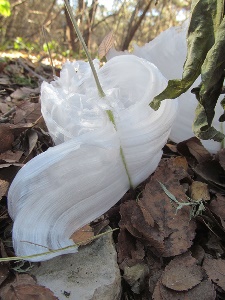 If the air is cold and still when a frost flower forms, ice layers push straight out into large silvery feathers. When conditions cause the leading edge of ice to thaw slightly as it forms, the frost flower will curl inward around the stem like cotton candy on a stick. Each layer of ice is so thin that the total frost flower is almost weightless and can shatter if touched. The formations never appear as exactly the same form.
If the air is cold and still when a frost flower forms, ice layers push straight out into large silvery feathers. When conditions cause the leading edge of ice to thaw slightly as it forms, the frost flower will curl inward around the stem like cotton candy on a stick. Each layer of ice is so thin that the total frost flower is almost weightless and can shatter if touched. The formations never appear as exactly the same form.
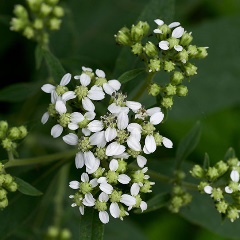 Frost flowers occur in Arkansas and in other parts of the world. However, only a few species of plants are known to produce them. Native Arkansas wildflowers that mature late in the year such as yellow ironweed (Verbesina alternifolia) and white crownbeard or wingstem (Verbesina virginica) is commonly called “frostweed.”
Frost flowers occur in Arkansas and in other parts of the world. However, only a few species of plants are known to produce them. Native Arkansas wildflowers that mature late in the year such as yellow ironweed (Verbesina alternifolia) and white crownbeard or wingstem (Verbesina virginica) is commonly called “frostweed.”
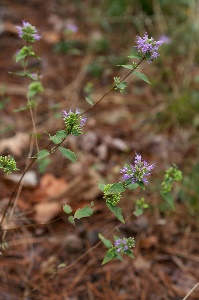 Another native plant called dittany or false oregano (Cunila origanoides) is also known to produce ice flowers. Stems of these plants are still green and tender in late fall and have a pithy core that can hold a lot of moisture — key factors in frost flower formation. Plants that are already dry and brittle before the first hard freeze will not produce ice flowers.
Another native plant called dittany or false oregano (Cunila origanoides) is also known to produce ice flowers. Stems of these plants are still green and tender in late fall and have a pithy core that can hold a lot of moisture — key factors in frost flower formation. Plants that are already dry and brittle before the first hard freeze will not produce ice flowers.
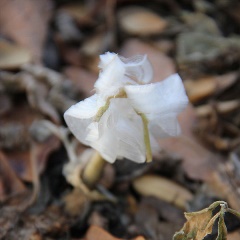 Unfortunately, frost flowers have a brief life span. The first rays of the sun soften their delicate edges and they melt quickly, so early morning is the best time to find them. Fencerows, stream banks, ditches, city lots, weedy gardens, and moist, open woodlands are all potential frost flower sites. Ice flowers often form again on the same plants with successive hard freezes until all of the moisture is driven from the stems.
Unfortunately, frost flowers have a brief life span. The first rays of the sun soften their delicate edges and they melt quickly, so early morning is the best time to find them. Fencerows, stream banks, ditches, city lots, weedy gardens, and moist, open woodlands are all potential frost flower sites. Ice flowers often form again on the same plants with successive hard freezes until all of the moisture is driven from the stems.
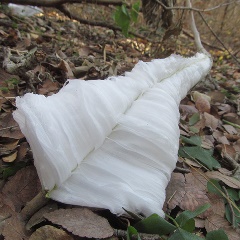 As the cold weather creeps in, be sure to grab your hat, gloves, and coat and head out in the early morning hours to see Jack Frost’s icy sculptures. There is something magical about discovering one of these beauties in the early morning hours — if you are lucky, a wispy ice flower awaits you. Until then, take a peak at the magic in this time-lapse video of a frost flower forming.
As the cold weather creeps in, be sure to grab your hat, gloves, and coat and head out in the early morning hours to see Jack Frost’s icy sculptures. There is something magical about discovering one of these beauties in the early morning hours — if you are lucky, a wispy ice flower awaits you. Until then, take a peak at the magic in this time-lapse video of a frost flower forming.
Photos:
Photo 1 — A ribbon-like frost flower. Photo by Justin Leigh Shaw, cropped and resized, used with permission under a CC BY-NC 2.0 license.
Photo 2 — White crownbeard or wingstem (Verbesina virginica), a native plant, is often called frostweed because it is one of the plants known to produce frostflowers. Photo by Eric Hunt.
Photo 3 — Dittany or false oregano (Cunila origanoides) is another native plant that is known to produce frostflowers. Photo by Eric Hunt.
Photo 4 — This frostflower is shaped like an actual flower bloom. Photo by Emily Frankoski, cropped and resized, used with permission under a CC BY-NC 2.0 license.
Photo 5 — You can clearly see the stem of the plant that produced this elongated frost flower. Photo by Justin Leigh Shaw, cropped and resized, used with permission under a CC BY-NC 2.0 license.
Main photo — A frost flower at Big Creek Natural Area. Photo by ANHC staff.
